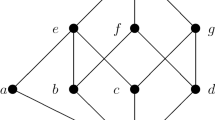Abstract.
A pair (x,y) of elements in a lattice is mismatching if x is join-irreducible, y is meet-irreducible, and xy. The excess of a lattice L is defined by ex(L):=|L|− min{|V x |+|I y |:(x,y) is mismatching}, where V x (I y ) is the principal filter (ideal) generated by x(y), respectively. In the first half of this paper, it is shown that a lattice has excess zero (one) if and only if it is isomorphic to a Boolean lattice (one of a chain of length two, a diamond, and a pentagon), respectively. In the second half, we show that for each relatively complemented lattice which is not Boolean, its size is at most five times its excess. Moreover we determine extremal configurations.
Similar content being viewed by others
Explore related subjects
Discover the latest articles and news from researchers in related subjects, suggested using machine learning.Author information
Authors and Affiliations
Additional information
Received: September 2, 1999 Final version received: July 25, 2000
Acknowledgments. The author thanks the referee for constructive comments.
Present address: Bureau of Human Resources, National Personnel Authority, 1-2-3 Kasumigaseki, Chiyoda-ku, Tokyo 100-8913, Japan. e-mail: abetet@jinji.go.jp
Rights and permissions
About this article
Cite this article
Abe, T. Excess of a Lattice. Graphs Comb 18, 395–402 (2002). https://doi.org/10.1007/s003730200029
Issue Date:
DOI: https://doi.org/10.1007/s003730200029



